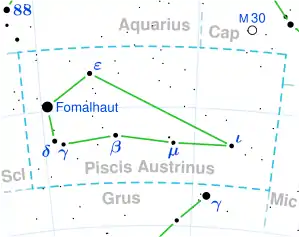TW Piscis Austrini
TW Piscis Austrini (also known as Fomalhaut B) is a main sequence star in the constellation Piscis Austrinus. It lies relatively close to the Sun, at an estimated distance of 24.8 light-years (7.6 parsecs). To an observer on Earth the star is visually separated from its larger companion Fomalhaut (A) by 2 degrees—the width of four full moons.[8]

 | |
| Observation data Epoch J2000 Equinox J2000 | |
|---|---|
| Constellation | Piscis Austrinus |
| Right ascension | 22h 56m 24.05256s[1] |
| Declination | −31° 33′ 56.0306″[1] |
| Apparent magnitude (V) | 5.44–6.51[2] |
| Characteristics | |
| Spectral type | K5Vp[3] |
| U−B color index | 1.02[4] |
| B−V color index | 1.10[4] |
| Variable type | BY Draconis[2] |
| Astrometry | |
| Radial velocity (Rv) | +6.79±0.12[1] km/s |
| Proper motion (μ) | RA: 330.203 mas/yr[1] Dec.: −158.602 mas/yr[1] |
| Parallax (π) | 131.5525 ± 0.0275 mas[1] |
| Distance | 24.793 ± 0.005 ly (7.602 ± 0.002 pc) |
| Absolute magnitude (MV) | 7.08[5] |
| Details | |
| Mass | 0.725 ± 0.036[3] M☉ |
| Radius | 0.629 ± 0.051[3] R☉ |
| Luminosity | 0.19[5] L☉ |
| Temperature | 4,711 ± 134[3] K |
| Rotation | 10.3[6] days |
| Rotational velocity (v sin i) | 2.93[3] km/s |
| Age | 440[5] Myr |
| Other designations | |
| Database references | |
| SIMBAD | data |
| ARICNS | data |
The name TW Piscis Austrini is a variable star designation. This is a variable star of the type known as a BY Draconis variable, with surface brightness variations causing the changes as the star rotates. It varies slightly in apparent magnitude, ranging from 6.44 to 6.51 over a 10.3-day period.[2]
TW Piscis Austrini lies within a light-year of Fomalhaut.[10] Due to sharing the same proper motion, and the same estimated age of approximately 440 ± 40 million years, astronomers now consider them to be elements of a multiple star system.[5] A third star, dimmer and more widely separated, Fomalhaut C, gives the system the widest visual separation, to observers from Earth, at approximately 6 degrees.[8]
Planetary system
In 2019, an exoplanet candidate around Fomalhaut B was detected by astrometry, but this remains unconfirmed.[11][12]
| Companion (in order from star) |
Mass | Semimajor axis (AU) |
Orbital period (years) |
Eccentricity | Inclination | Radius |
|---|---|---|---|---|---|---|
| b (unconfirmed) | 1.2+0.7 −0.6 MJ |
— | 25+52 −21 |
— | — | — |
References
- Vallenari, A.; et al. (Gaia collaboration) (2023). "Gaia Data Release 3. Summary of the content and survey properties". Astronomy and Astrophysics. 674: A1. arXiv:2208.00211. Bibcode:2023A&A...674A...1G. doi:10.1051/0004-6361/202243940. S2CID 244398875. Gaia DR3 record for this source at VizieR.
- Samus, N. N.; Durlevich, O. V.; et al. (2009). "VizieR Online Data Catalog: General Catalogue of Variable Stars (Samus+ 2007-2013)". VizieR On-line Data Catalog: B/GCVS. Originally Published in: 2009yCat....102025S. 1: B/gcvs. Bibcode:2009yCat....102025S.
- Demory, Brice-Olivier; Ségransan, Damien; Forveille, Thierry; Queloz, Didier; Beuzit, Jean-Luc; Delfosse, Xavier; Di Folco, Emmanuel; Kervella, Pierre; Le Bouquin, Jean-Baptiste; Perrier, Christian; Benisty, Myriam; Duvert, Gilles; Hofmann, Karl-Heinz; Lopez, Bruno; Petrov, Romain (October 2009). "Mass-radius relation of low and very low-mass stars revisited with the VLTI". Astronomy and Astrophysics. 505 (1): 205–215. arXiv:0906.0602. Bibcode:2009A&A...505..205D. doi:10.1051/0004-6361/200911976. S2CID 14786643.
- Johnson, H. L.; Mitchell, R. I.; Iriarte, B.; Wisniewski, W. Z. (1966). "UBVRIJKL photometry of the bright stars". Communications of the Lunar and Planetary Laboratory. 4 (99): 99. Bibcode:1966CoLPL...4...99J.
- Mamajek, E.E. (August 2012). "On the Age and Binarity of Fomalhaut". Astrophysical Journal Letters. 754 (2): L20. arXiv:1206.6353. Bibcode:2012ApJ...754L..20M. doi:10.1088/2041-8205/754/2/L20. S2CID 119191190.
- Mamajek, Eric E.; et al. (2013). "The Solar Neighborhood. XXX. Fomalhaut C". The Astronomical Journal. 146 (6): 154–163. arXiv:1310.0764. Bibcode:2013AJ....146..154M. doi:10.1088/0004-6256/146/6/154. S2CID 67821813.
- "V* TW PsA -- Variable of BY Dra type". SIMBAD. Centre de Données astronomiques de Strasbourg. Retrieved 2010-01-20.
-
Bob King (2014-10-01). "Fomalhaut: A crazy-wide triple stat". Sky & Telescope. Retrieved 2020-06-13.
Though it may appear isolated in the barren October sky, Fomalhaut has company. It feels the gravitational tug of the magnitude +6.5 star TW Piscis Austrini, 2° to the south. Both are 25 light-years distant and move in tandem across space, partaking of the same proper motion. They form a true double star with an actual separation of 5.5 trillion miles, or 0.91 light-year.
- Busko, I. C.; Torres, C. A. O. (March 1978). "Flare activity by BY Draconis stars". Astronomy and Astrophysics. 64: 153–160. Bibcode:1978A&A....64..153B. Retrieved 23 February 2022.
- Fred Schaaf (31 March 2008). The Brightest Stars: Discovering the Universe through the Sky's Most Brilliant Stars. Wiley. ISBN 978-0-470-24917-8.
-
Joe Rao (2019-09-23). "Fomalhaut, 'Royal' Star of Autumn, Swims with the Southern Fish". Space.com. Retrieved 2020-06-13.
Believe it or not, an extrasolar planet might also be circling TW Piscis Austrini. NASA's Transiting Exoplanet Survey Satellite (TESS), a space telescope that's searching for planets around the brightest stars in Earth's night sky, recently found a possible candidate circling this star. It's almost the same size as our Earth, and orbits the star about every 10 days at a distance of 7.5 million miles from it.
- De Rosa, Robert J.; Esposito, Thomas M.; Hirsch, Lea A.; Nielsen, Eric L.; Marley, Mark S.; Kalas, Paul; Wang, Jason J.; Macintosh, Bruce (7 October 2019). "The Possible Astrometric Signature of a Planetary-mass Companion to the Nearby Young Star TW Piscis Austrini (Fomalhaut B): Constraints from Astrometry, Radial Velocities, and Direct Imaging". Astronomical Journal. 158 (6): 225. arXiv:1910.02965. Bibcode:2019AJ....158..225D. doi:10.3847/1538-3881/ab4c9b. S2CID 203902656.